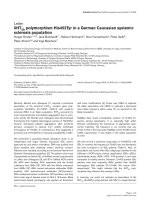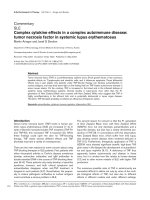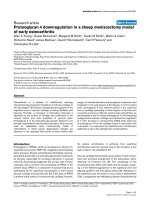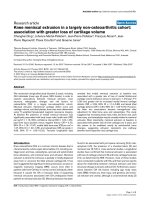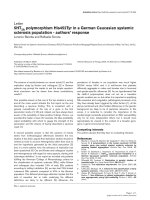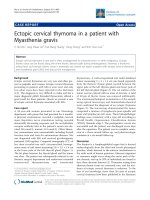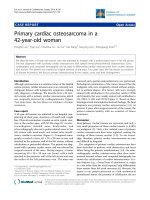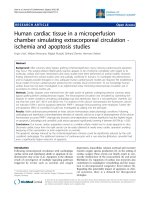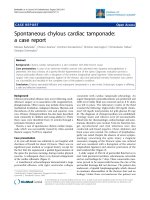Báo cáo y học: " Mopane worm allergy in a 36-year-old woman: a case report" pptx
Bạn đang xem bản rút gọn của tài liệu. Xem và tải ngay bản đầy đủ của tài liệu tại đây (270.79 KB, 4 trang )
CAS E RE P O R T Open Access
Mopane worm allergy in a 36-year-old woman:
a case report
Okechukwu A Okezie
*
, Koloi K Kgomotso, Mavis M Letswiti
Abstract
Introduction: The increasing incidence of new diseas es as well as changing features of known diseases has partly
been attributed to the impact of environmental changes. As a result, there have been calls from health experts for
proper surveillance and monitoring of these changes.
This is a report of mopane worm allergy in a 36 year old female from the Tswana tribe in Botswana. Mopane
worm, the caterpillar stage of Gonimbrasia belina moths, is a seasonal delicacy to people in many communities in
southern Africa. As a result, by adulthood, many residents of these communities have had substantial exposure to
the worm. Gonimbrasia belina moths belong to the Lepidoptera order of insects. Though some members of this
order are known to induce contact allergy, there is no reported incidence of ingestion allergy from mopane worm.
Therefore, it is important to track this case for its epidemiological significance and to alert both clinicians and the
vulnerable public on the incidence of mopane worm allergy in this region.
Case presentation: This is a case of a 36 year old woman from the Tswana ethnic group in Botswana, who was
diagnosed with food allergy. She presented with itchy skin rash, facial swelling, and mild hypotension after eating
mopane worm. She had no previous history of allergic reaction following contact or ingestion of mopane worm
and had no atopic illness in the past. She was treated and her symptoms resolved after 4 days.
Conclusion: The proper man agement of allergy involves patients’ avoidance and clinicians’ predictability. Though
hypothetical, this report is expected to sensitize clinicians to anticipate and properly manage subsequent
occurrence, as well as educate the public in these communities. In addition, tracking new disease patterns, wi th
relationship to environmental changes, will compliment existing evidence in validating the importance of proper
environmental surveillance and management.
Introduction
In spite of the recent aversion in some developed coun-
tries, the eating of insects is still wide spread. Caterpil-
lars and termites are the most eaten and marketed
insects in Africa [1]. Among these are Mopane worms;
caterpillars that hatch in early spring from eggs of
Gonimbrasiabelinamoths. They are mostly seen on
Colophospermum mopane trees where they mature
within six weeks. Due to its high nutritional content,
palatability, ease of processing and storage, mopane
worm is an accessible nutritious supplement and a
source of income for some people in Southern African
communities [1].
In spite of widespread hu man contacts through seaso-
nal harvesting and ingestion in these communities, there
is no documented case of mopane worm allergy [2].
Food allergy, like other allergic conditions, is the result
of th e body’s immune reactions to proteins, in this case,
food proteins [3]. Immunological [IgE] association dis-
tinguishes food allergy from food intolerance which is
the commonest food related reaction [4]
Food allergies like intolerance is more common in
children due to early exposures to the trigger proteins
before their immune system is matured enough to han-
dle these proteins [4-6]. With maturity, most allergic
responses to some proteins may wane or completely dis-
appear [7].
The conscious selection of foods in the environment
and avoidance of harmful substa nces is an evolutionary
characteri stic of living organisms, including man. There
* Correspondence:
Tshepo Clinic, Botswana Harvard Partnership, Hospital Road, Private Bag
BO320, Gaborone, Botswana
Okezie et al. Journal of Medical Case Reports 2010, 4:42
/>JOURNAL OF MEDICAL
CASE REPORTS
© 2010 Okezie et al; licensee BioMed Central Ltd. This is an Open Access article distributed under the terms of the Creative Commons
Attribution License ( which p ermits unres tricted use, distribution, and repro duction in
any medium, provided the original work is properly cited.
is usually a clear distinction between harmful and safe
foods in a stable ecology.
As a result, apart from known idiosyncratic intoler-
ance/allergies to known foods such as peanuts, tree
nuts, milk, soy, wheat, eggs and sea foods, which
account for about 90% of food allergies [7,8], unprece-
dented allergies from safe and uncontami nated foods
are rare.
Elements of the environment are said to affect human
health in two ways; through pathogenic agents and phy-
sical and chemical agents such as radiation, chemical
compounds and emissions of gases, liquids or solids [9].
Over the last two decades, environmental activities
and their impacts on life have raised concerns among
health experts o n future threats to human health
[10-12].
The importance of maintaining the balance in the eco-
system was emphasiz ed by Eric Chivian who elaborated
the vital function of the ecosystem in regulating the
concentration of oxygen, carbon dioxide a nd water
vapour in the atmosphere, filtering pollutants from
drinking water, regulatin g global te mperature and preci-
pitation, forming soil and keeping it fertile, pollinating
plants, and providing food and fuel [13].
The rising incidence of microbial diseases such as pla-
gue, cholera, Lyme disease, and West Nile viral infec-
tions have b een linked to microbi al activities in
response to global environmental changes [12].
Similarly, there is increasing global prevalence of aller-
gic diseases due to ozone impact and new dietary habits,
among other factors [10]
As a result, WHO and other public health experts
have advised on p roper public health surveillance and
response to these emerging health t hreats, due to the
impact of environmental changes [11-13].
Mopane worm ingestion is popular amongst most
tribes in southern Africa. And recently, excessive har-
vesting in these regions has raised fears of the worm
extinction [1].
The production of proteins and peptide, which are
necessary for specie sustenanceatthetreatofextinc-
tion, is an adaptive characteristic of the insect species
[10]. Though allergic reactions are also triggered by pro-
teins, this report does not have the statistical strength to
correlate the emergence of mopane worm allergy to
adaptive response of these worms to selective pressure.
However, by tracking this new case, which is significant
to So uth African communities, a logical argument could
be made for intensified surveillance and monitoring of
health events from environmental manipulations, includ-
ing presumed harmless activities in vulnerable
communities.
Case presentation
On 16/01/08, a 36 year old female presented to a Private
Hospital in Botswana. She is a hospital nu rse from the
Tswana tribe in B otswana. She i s married and has 2
children.
She complained of progressive body swelling that was
worse on the face and generalized itchy body rash,
malaise and nausea. She revealed ingestion of about 20
grams of mopane worm, 2 hours before the onset of
symptoms. She had lived in Botswana all her life and
had eaten mopane worm most of its season since child-
hood. She has had neither personal nor family history of
similar symptoms or atopic syndrome. Except for occa-
sional headache often attributed to tension headache,
she had no significant medical history.
She had taken 4 mg of pediatric chlopheniramine
syrup before going to the hospital.
According to the records from the accident and emer-
gency of t he hospital, h er initial assessment revealed
that she was anxious, but physically stable.
She had generalized maculopapular rash, normal sys-
temic [cardio respiratory] function, mild hypotension.
Her vital signs were ; Blood Pressure 90/50 mmHg;
Pulse Rate 110/minutes; Respiratory Rate 14/minutes.
A diagnosis of food allergy was made.
She was treated with intramuscular injection of adre-
nalin followed by intravenous Hydrocortisone and pro-
methazine through a venous line. The venous line was
maintained until she received I lit er of no rmal saline
drip over 8 hours, while being observed.
She was discharged on oral chlopheniramine.
Two days later, she presented to our clinic with
increasing rash, facial swelling, nausea, dizziness and yel-
lowness of the eyes. There was no vomiting and patient
reported a daily flui d intake of up to two and half liters
and a good urine output.
She confirmed eating an unusually large quantity of
mopa ne warm with the rest of the family members. S he
had been eating and tolerating the warm in most of the
season since child hood.
On clinical examination, she had generalized macular
exanthem, periorbital swelling, mild conjunctiva inges-
tion, pale extremities [palms] and dry lips.
Her vital signs were normal; Blood Pressure was 110/
65 mmHg; Pulse Rate was 78/minutes; Respiratory Rate
was 12/minutes. Examinations of the systems in the
body were normal.
Her urine was tea colored but dipstick test was nor-
mal. Liver function test was also normal; White Blood
Cell was marginally high at 11000 with predominant
neutrophyls. Eosinophil ratio to other cells was
normal.
Okezie et al. Journal of Medical Case Reports 2010, 4:42
/>Page 2 of 4
Reaffirming the diagnosis of food allergy, we started
her on high dose prednisolone and promethazine but
discontinued chlopheniramine.
We advised her to drink lots of fluid, at least 3 liters
daily, avoid the worm, and return if she didn’tfeelbet-
ter. When called on 19/01/08, she said she felt much
better.
On 21/01/08 she returned for assessment. She was
well, so we stopped her promethazine and started tailing
off her prednisolone. She was discharged and told to
commence her routine activities on the 23/01/08.
Conclusion
Relevant measures aimed at preserving the natural
environment and forestalling emerging health conse-
quences of environmental degradation have been pre-
scribed. Nonetheless, the complexity of the earth’ s
ecology and its activities, limits accurate prediction of
these health impacts, and makes appropriate preventive
solutions, elusive.
The effect of this limitation is more felt in develop ing
country with competing priorities.
The rising incidence of allergic conditions among
other diseases has been attributed to the disruption of
ecosystem. Though it may be difficult at the clinic level
to forestall this trend, accurate diagnosis and treatment
is vital in tracking and reducing the impact of these
diseases.
Food allergy is diagnosed from medical history, speci-
fic skin test and IgE identification [14].
With the clinical relevance of positive skin prick test
and find ing of food specific IgE limited by sensitization
in patients, demonstration of a provoked allergy induced
reaction in patient is the identified gold standard in
diagnosis [14]
Management of allergi c conditions like most medical
condition in limited resource sett ings is guided by his-
tory, symptoms and signs. Care protocol is aimed at
patient’s comfort and sat isfaction while conserving cost.
Therefore, provocative tests are rarely done after symp-
tom resolution has been achieved by empirical treat-
ment. The target is usually to initiate treatment,
monitor response, and confirm diagnosis on the basis of
timing and association of symptoms to clinical presenta-
tion as well as response to treatment. Diagnosis is
further supported by symptom relief if suspected cause
is removed and reoccurrence of symptom if reintro-
duced [15]
Allergic reactions from pre exposed substance are
usually identified earlier in individuals; hence, predict-
ability makes it a r elatively avoidable and manageable
clinical condition in adults.
However, this case report challenges this premise and
validates theories on immunologic dynamism from
multiple factors such as disease, genetics environment,
etc, which make accurate understanding of most related
diseases and symptom spectrum elusive.
Also significant, is the s peculation that the timing of
the event in this report raises in the light of r ecent fears
of mopane worm extinction from overhavesting.
Anthropological reports support the theory that t he
imminent threat of extinction of a seasonal worm with a
short life span can trigger rapid adaptive changes, which
include production of protein with protective functions.
These protective functions, among others, include
unprecedented protein sensitization and food allergies
that may range from reaction such as this case, to life
threatening anaphylaxis and poisoning.
This speculation further supports the safe logic that
planned activities towards reversing the harmful impact
of disturbances in the ecosystem should be guided by
proper understanding of nat ural activities in the system,
in this case, the innate adaptive ability of organisms to
selective pressures.
In emphasizing the importance of understanding the
mutual biological and environmental modifications in
global change for a sound policy decision and regula-
tions, Dr. James M. Tiedje, Michigan State University,
an author of the report who chairs ASM’s Committee
on Environmental Microbiology stated;
“We must better understand the human-microbe part-
nership so that environmental decisions that impact
microbial processes will achieve appro priate balances in
the atmosphere and biosphere. Otherwise, we will be
increasingly challenged by unp recedented environmental
problems,” [11]
In the light of these, this report responds to the call
for the tracking and monitoring of emerging disease pat-
terns related to environmental changes.
It also gives interesting insights on the complexity of
the interactions in the ecosystem, including specie adap-
tations and other activities. A thorough understanding,
of which is vital for a comprehensive environmental
management for health promotion.
Most importantly this original report raises a hypoth-
esis that may motivate clinicians involvement in public
health activ ities that includes environment surv eillance
and public education
Consent
Written informed consent was obtained from the patient
for publication of this case report and accompanying
images. A copy of the written consent is available for
review by the Editor-in-Chief of this journal.
Abbreviations
ASM: American Society for Microbiology; mg: milligram; mmHg: millimeter
mercury.
Okezie et al. Journal of Medical Case Reports 2010, 4:42
/>Page 3 of 4
Acknowledgements
We wish to acknowledge the Tshepo Clinic staffs for their relentless efforts
towards good clinical practice, team work, and good relationship with
patients.
Authors’ contributions
ML performed the nursing care, retrieved and compiled this patient’s
personal and family medical records.
KK analyzed and interpreted all available medical data on food allergy from
the hospital records and internet.
OO provided clinical care and was a major contributor in writing the
manuscript.
All authors read and approved the final manuscript.
Competing interests
The authors declare that they have no competing interests.
Received: 14 April 2008
Accepted: 6 February 2010 Published: 6 February 2010
References
1. Gullan PJ, Granan VS: The insect; an outline of entomology , 313-14.
2. Auerswald L, Lopata A: Insect Diversity and allergy; Current allergy and clinical
immunology 2005, 18(2):58-60.
3. Allergies Related to Food Insect Production and Consumption; the Food
Insects Newsletter. 1995, III, Downloaded
on 20/01/08.
4. Zopf Y, Baenkler H-W, Silbermann A, Hahn EG, Raithel M: The differential
diagnosis of food intolerance. Dtsch Arztebl Int 2009, 106(21):359-70.
5. Sampson HA: Food allergy: primer on allergic and immunologic diseases.
JAMA 1997, 288:1888-1894.
6. Croner S: Prediction and detection of allergy development: influence of
genetic and environmental factors”. J Pediatr 1992, 121:58-63.
7. Lack G: Food Allergy. N Engl J Med 2008, 359:1252-60.
8. National Institute of Allergy and Infectious Diseases; Food Allergy: An
Overview. 2004 Publication No. 04-
5518.
9. Tolba MK, El-Kholy OA, El-Hinnawi E, et al: The world environment 1972-
1992: Two decades of challenge.Chapter 18:529-67.
10. Campbell-Lendrum D, Corvalán C, Neira M: Global climate change;
implications for international public health policy. Bulletin of the World
Health Organization 2007, 85(3):161-241.
11. Dimarcq JL, Hunneyball I: When bugs become drugs. Drug Discovery Today
2003, 8(3):107-110 Downloaded on
01/04/08.
12. Global Environmental Change: Microbial Contributions, Microbial
Solutions Science Daily (Feb. 14, 2001) downloaded from http://www.
sciencedaily.com on 18/1/08. .
13. Chivian E: Environment and health: 7. Species loss and ecosystem
disruption; the implications for human health. CMAJ 2001, 64(1):66-69.
14. Seitz CS, Pfeuffer P, Raith P, Bröcker E-B: Axel Trautmann Food allergy in
Adult: An Over- or Underrated Problem?. Dtsch Arztebl Int 2008,
105(42):715-23.
15. Motala C, Steinman H: Food allergy, preservatives and Asthma.http://
www.asthma.co.za, Downloaded on 26/11/08.
doi:10.1186/1752-1947-4-42
Cite this article as: Okezie et al.: Mopane worm allergy in a 36-year-old
woman:
a case report. Journal of Medical Case Reports 2010 4:42.
Submit your next manuscript to BioMed Central
and take full advantage of:
• Convenient online submission
• Thorough peer review
• No space constraints or color figure charges
• Immediate publication on acceptance
• Inclusion in PubMed, CAS, Scopus and Google Scholar
• Research which is freely available for redistribution
Submit your manuscript at
www.biomedcentral.com/submit
Okezie et al. Journal of Medical Case Reports 2010, 4:42
/>Page 4 of 4
